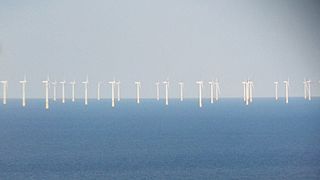
Horns Rev is a shallow sandy reef of glacial deposits in the eastern North Sea, about 15 km (9.3 mi) off the westernmost point of Denmark, Blåvands Huk. The reef contains the Horns Rev Offshore Wind Farm.
Ørsted A/S is a Danish multinational energy company. Headquartered in Fredericia, Denmark, Ørsted is the largest energy company in Denmark. The company adopted its current name on 6 November 2017. It was previously known as DONG.
The Thanet Wind Farm is an offshore wind farm 7 miles (11 km) off the coast of Thanet district in Kent, England. On commissioning it was the world's largest offshore wind farm. It has a nameplate capacity of 300 MW and it cost £780–900 million (US$1.2–1.4 billion). Thanet is one of fifteen Round 2 wind projects announced by the Crown Estate in January 2004 but the first to be developed. It was officially opened on 23 September 2010, when it overtook Horns Rev 2 as the biggest offshore wind farm in the world. It has since been overtaken by many others.

Gwynt y Môr is a 576-megawatt (MW) offshore wind farm located off the coast of north Wales and is the fifth largest operating offshore windfarm in the world. The farm has 160 wind turbines of 150 metres (490 ft) tip height above mean sea level.

The Barrow Offshore Wind Farm is a 30 turbine 90MW capacity offshore wind farm in the East Irish Sea approximately 7 kilometres (4.3 mi) south west of Walney Island, near Barrow-in-Furness, Cumbria, England.

The Burbo Bank Offshore Wind Farm is a 348 MW offshore wind farm located on the Burbo Flats in Liverpool Bay on the west coast of the UK in the Irish Sea. It consists of an original 90 MW wind farm commissioned in 2007 and a 258 MW extension completed in 2017.

Gunfleet Sands Offshore Wind Farm is a 172 MW wind farm about 7 kilometres (4.3 mi) off the Clacton-on-Sea coast in the Northern Thames Estuary.
Race Bank Wind Farm is a 573 MW Round 2 offshore wind farm located 27 km north of Blakeney Point off the coast of Norfolk, and 28 km east of Chapel St Leonards off the Lincolnshire coast in the North Sea. The farm was commissioned in February 2018.

Westermost Rough Wind Farm is an offshore wind farm 8 kilometres (5 mi) north east of Withernsea off the Holderness coast, in the North Sea, England. The farm covers an area of approximately 35 km2 (14 sq mi) with a generation capacity of approximately 210 MW. It became operational in May 2015.

Walney Wind Farms are a group of offshore wind farms 9 miles (14 km) west of Walney Island off the coast of Cumbria, England, in the Irish Sea. The group, operated by Ørsted, consists of Walney Phase 1, Phase 2 and the Walney Extension. The extension has a capacity of 659 MW and it was the world's second largest offshore wind farm in 2018.
The European Offshore Wind Deployment Centre (EOWDC), also known as the Aberdeen Bay Wind Farm is an offshore wind test and demonstration facility located around 3 kilometres off the east coast of Aberdeenshire, in the North Sea, Scotland. It was developed by the European Offshore Wind Deployment Centre consortium. The scheme is relatively small - it consists of 11 wind turbines with an installed capacity of 93.2 megawatts. It is located between Blackdog and Bridge of Don near Aberdeen. First power was generated in July 2018, with full commissioning following in September 2018.
Hornsea Wind Farm is a Round 3 wind farm which began construction in 2018. Sited in the North Sea 120 km (75 mi) off the east coast of England, the eventual wind farm group is planned to have a total capacity of up to 6 gigawatt (GW).
SouthCoast Wind, formerly known as Mayflower Wind, is a proposed offshore wind farm in U.S. federal waters about 30 miles south of Martha’s Vineyard and 23 miles south of Nantucket, Massachusetts with an name plate capacity of 804 MW in Lease OCS-A 0521, which covers 127,388 acres. Construction is expected to start in the mid-2020s.
The United Kingdom became the world leader of offshore wind power generation in October 2008 when it overtook Denmark.






